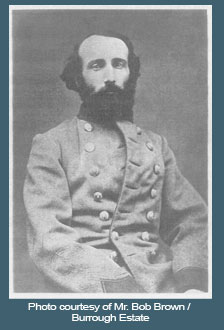Story of the Lost Gunners Quadrant

In 1895, the aging former commander of the
Confederate Fayetteville Arsenal, Lt. Col. Frederick L. Childs,
passed
away
and was buried in the quiet cemetery of the Church of the Holy
Cross in
Stateburg,
South Carolina.[1]
The old
Confederate veteran went to his grave without ever recovering
a
treasured
piece of his father’s military past that had been passed down to
him.
Childs’s
gunner’s quadrant and other personal belongings fell victim to
Sherman’s engineers when
they
razed the Fayetteville Arsenal. Amazingly, almost a century later,
the
quadrant
was returned to the Childs family under the most curious of
circumstances.
Frederick L. Childs was the only son
of an
American military hero, Bvt. Brig. Gen. Thomas Childs. Thomas
Childs
entered
the United States Army in 1814 at the tender age of 16, while
the
country
was at war with England.
While a
cadet at West Point, Thomas accepted
an
early commission from the Army to help meet the needs of the
service. The
teenager
led his detachment against British forces at the 1814 Battle of
Fort
Erie.
The young lieutenant distinguished himself during the battle by
capturing
British
Artillery Battery No. 3. After killing or capturing the
British
soldiers
manning the battery, Childs and his men spiked the guns and
destroyed
the
powder magazine. The valuable ordnance materiel seized by
young
lieutenant’s
detachment was then turned over to the War Department.
Congress commended the bravery of
Lieutenant
Childs during the battle by having one of the captured
brass
gunner’s
quadrants engraved and presented to the young officer. The
inscription
read as
follows: "Captured
from
the British at the Sortie from Fort Erie
on he
17th of September, 1814, by Lieutenant Thomas Childs, who commanded
the
detachment
that spiked the guns and blew up the magazine of Battery No. 3,
at
the age
of 16."
Childs served in the Army for
another
39 years, rising to the rank of brevet brigadier general. He
died in
1853
while serving in Tampa,
Florida.
Following his death, his
only
son, Frederick L. Childs, became the steward for the treasured
quadrant.
Unlike
his father, Frederick graduated from West Point before joining the
ranks of the United States
Artillery.
Throughout his service in the United
States
Army and the Confederate Army, Frederick Childs carried the
quadrant
with
him. As Sherman approached Fayetteville in March 1865,
Childs
accompanied
the materiel and equipment evacuated from the Arsenal, leaving
the
quadrant
in the care of his mother and sister at their residence on the
Arsenal
grounds.
Following Sherman’s
arrival
at the Arsenal, Mrs. Childs approached the general, seeking
protection
for the
family’s property. She hoped Sherman
would
show leniency to her based on the Union commander’s relationship
with her
late
husband years earlier. Rebuffed by Sherman
for her son’s traitorous acts, Mrs. Childs was left to the mercy of
Sherman’s men, who showed
little
sympathy for the aging widow. Their quarters and all of their
personal
belongings
were either destroyed by fire or dumped into the Cape
Fear
River along with other items from the Arsenal.
From 1865 on, only the story of the
quadrant
was passed down through the Childs family. But this story had a
happy
ending.
In 1932 a night watchman at the Norfolk Naval
Hospital
named Paul
Watson
learned that a patient, Marine Corps Lt. W. W. Childs, had been in
a
traffic
accident and had been admitted for treatment. The curious
Watson gained
permission
to visit Childs from the hospital staff.
Watson introduced himself to the
lieutenant
and informed him that his father, a salvage diver, had dived
the
Cape
Fear River in the early 1900s in an effort to recover scrap metal
from the
Arsenal
dumped there by Sherman’s
men.
His father discovered an engraved brass gunner’s quadrant inscribed
to a
Lt.
Thomas Childs. The elder Watson decided to hold onto it in
the hope of one
day
identifying its rightful owner. The years passed, and the
quadrant was
handed
down to another generation.
After hearing Watson’s story,
Lieutenant
Childs informed him that Lt. Thomas Childs was his
great-grandfather.
Coincidentally, Childs happened to have the military
commissions
of his great grandfather and grandfather in the car with him on
the
day of
the accident. He showed the two commissions to Watson, who
did the noble
thing
and returned the quadrant to its rightful owners, his family’s
mission
finally
completed. One can only imagine the delight felt by
Lieutenant Childs
to have
so treasured and storied a military item back in the
family’s
possession
after so many years.[2]
[1] “Historic Old Southern Home,” Confederate Veteran, vol. 37, April 1919, p. 130.
[2] Mrs. Stephen E. Puckett, “Long Lost Present From Congress To Young Officer in War of 1812 Recovered by His Great Grandson,” Columbia S.C. State, September 4, 1932.

Lt. Col. Fredrick L. Childs